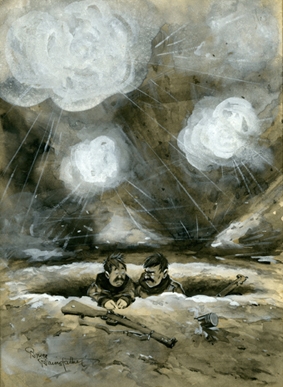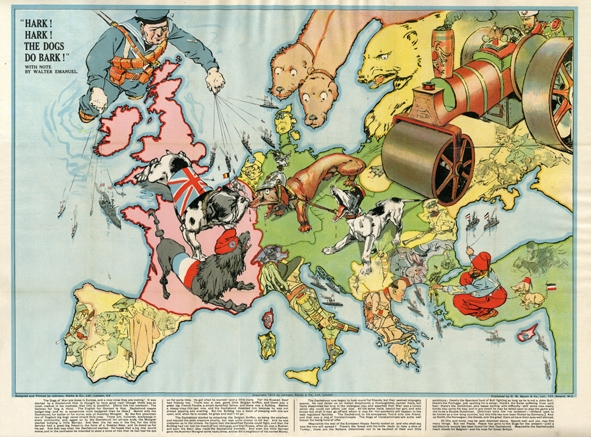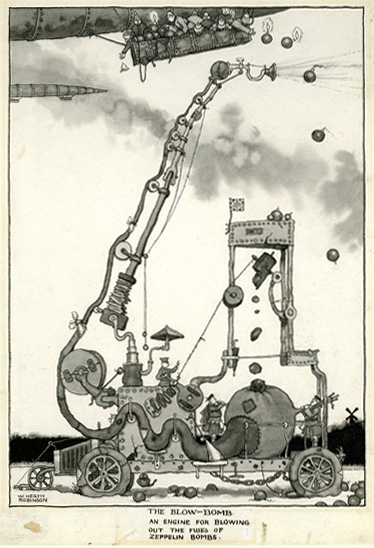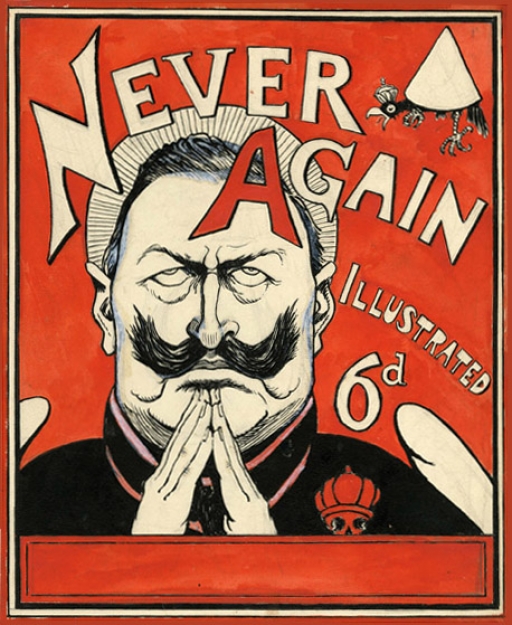Mike Swain reports on an exhibition of popular First World War cartoons in London which reveals a different insight into the attitudes of people to the war on the battlefield and at home.
Some of the most powerful and memorable images from the First World war come from cartoons.
While they are an art form in themselves they also reflect popular culture and give an insight into the social attitudes of ordinary soldiers at the Front and the lives of families at home which is different to the narrative of official history.
“Never Again,” a Centenary exhibition of Cartoon and Comic Art at the Cartoon Museum, Little Russell Street, London, gives a fascinating and often surprising view of the lives of both Tommies and German Lancers in the war.
The exhibition features leading cartoonists such as Alfred Leete, Bruce Bairnsfather and William Heath Robinson.
Lord Kitchener
Cartoons range from Leete’s famous Lord Kitchener recruiting poster to Bruce Bairnsfather’s grumbling but steadfast soldier ‘Old Bill’.
‘Old Bill’ became the face of the long-suffering Tommy in the trenches. Criticised in parliament as ‘vulgar caricatures of our heroes’, Bairnsfather’s down-to-earth drawings were loved by the men at the front.
They were reproduced on plates and cards and inspired stage shows and films. The exhibition includes Bairnsfather’s ‘Well, if you knows of a better ’ole, go to it’, widely regarded as the most famous cartoon of the war.

‘Well, if you knows of a better ‘ole go to it! Bruce Bairnsfather 1915. Courtesy of Cartoon Museum
Cartoonists were at the forefront of bolstering the war effort. So, while there are many which ridicule the enemy and show the stoic humour and the shared deprivations on all sides of fighting the war, there are others which reflect an intense patriotism.
Museum director and exhibition curator Anita O’Brien told me: “There’s a postcard there which says, “I can’t love a man who hasn’t died for his country!” which really says it all.
“The exhibition is really a combination of what was available and looking at material in different ways that people might not think about in the sense of the thoughts that people had, the Home Front as well as on the battle front.
“I was very keen to include some perspective from the German point of view. A lot of the German postcards were very forceful in their sense of “Germany is strong” and “We can do it,” from East and West.
“I thought there must be something more to it than just this kind of card so we find cards of men confronting lice.
“British kit weighed 60 pounds but the German kit weighed 75 pounds so the Germans and the British Tommy in the trenches had a lot in common in their conditions.”
Postcards
The 300 images range from political and joke cartoons from newspapers and magazines to colourful comic postcards by the likes of Donald McGill and Douglas Tempest on a huge range of subjects, including life in the trenches, popular songs, food shortages and air raids.
Anita said: “It was really the height of the postcard era. Before telephones, postcards were much more common. People sent postcards several times a day.”
There are also children’s comics such as Picture Fun and Comic Life, cigarette cards and maps.
And there are trench publications produced by serving soldiers, many of which featured cartoons, which have been extensively researched by Professor Jane Chapman from the University of Lincoln.
The publications, similar to the Wipers Times, and produced by Canadian, New Zealand and Australian soldiers, reflect a satirical reaction to the food, drink, medical facilities inadequate leave and military discipline.
Many cartoons feature national symbols such as John Bull, the Russian Bear and the French Cockerel. Leaders such as Kitchener and the Kaiser – who often appeared with his son in Haselden’s ‘Big and Little Willie’ were also popular subjects.

Hark! Hark! The Dogs do Bark 1914. Courtesy of the Cartoon Museum.
There are ‘hate cartoons’ by Edmund J. Sullivan which demonise the Germans, but others by Heath Robinson and Haselden that acknowledge the humanity shared by both sides.
The impact of modern warfare, air raids and women’s war work all appear as subjects, as do conscription and conscientious objectors.
Daily Mirror
Anita said: “Another thing to remember is that a lot of the newspapers at that time did not have cartoons in them so The Times, the Telegraph, The Observer, The Guardian, none of these had cartoons in them.
“So we have quite a lot of the Daily Mirror and magazines like the Daily Graphic and The Graphic.
“The very first cartoons depict the mud, the grumbling, the bad food. The men loved those cartoons because they captured the feeling of what it was really like. There’s a certain pathos there.
“It really does give you a flavour of the time – the ideals and the pressures – there are things like references to prostitutes.
“And of course at the beginning everyone thought there would be this awful big offensive and they would be home by Xmas and by energy and enthusiasm you would win the day.
“Then armies dug in, it became a defensive war and people were in for the long haul.
“And then you have Americans and the modern warfare – the first war in which gas is used there were tanks, airplanes and Zeppelins.”

The Blow-Bomb. An engine for blowing out the fuses of Zeppelin Bombs. William Heath Robinson. 1916. Courtesy of the Cartoon Museum
The cartoons reflect the way the war changed society such as sending women into the workplaces to replace men.
There’s a W.K Haselden cartoon showing a male boss in front of women workers telling them: “A little pin money.” They reply sarcastically: “How kind, how generous of you. But all we want is your approval.”
A second drawing shows the chastened boss’s “slow but inevitable awakening.” The caption says: “Good pay for Good work. And no nonsense about it!”
It would not be out of place today. For me these themes of: ‘Don’t take us for mugs,’ the pride, the resistance to being exploited, the shared knowledge that the Lancer was suffering as much as the Tommy in the trenches, are all a counter balance to the more simple, sentimental and patronising historical view of heroes and “lions.”
The cartoons reveal a healthy, grumbling scepticism and a quick rebuke to anyone exploiting the war for their own greed.
Anita added: “Of course cartoons are art. People use cartoon art to make a statement whether it is for propaganda purposes or ones that are critical of the government or people in the government. There’s one by Will Dyson criticising extravagance.
“I don’t know how people will respond to the exhibition. Hopefully they will say there is an awful lot there – lots of different themes and I hope people will discover different things.
“We can’t tell the story of the war and I don’t think people would want us to. There are enough exhibitions doing that already. I think this gives more of the social side.”
‘Never Again’, Cartoon Museum, 35 Little Russell Street, London WC1A 2HH.
www.cartoonmuseum.org
Exhibition runs to October 19 2014
Posted by Mike Swain, Deputy Editor, Head of Features, Centenary News
